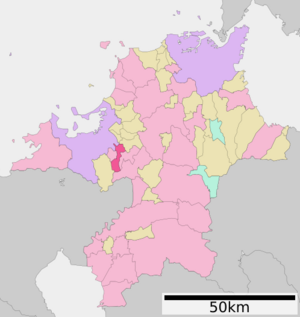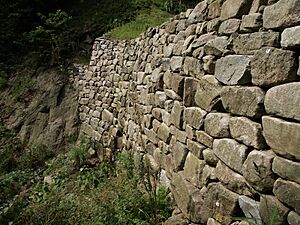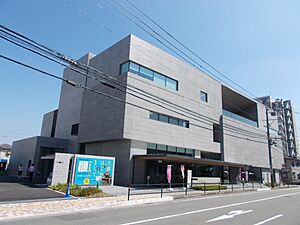Ōnojō facts for kids
Quick facts for kids
Ōnojō
大野城市
|
|||||||||||
|---|---|---|---|---|---|---|---|---|---|---|---|

Ōnojō City Hall
|
|||||||||||
|
|||||||||||
 |
|||||||||||
| Country | Japan | ||||||||||
| Region | Kyushu | ||||||||||
| Prefecture | Fukuoka | ||||||||||
| Area | |||||||||||
| • Total | 26.89 km2 (10.38 sq mi) | ||||||||||
| Population
(March 31, 2024)
|
|||||||||||
| • Total | 102,818 | ||||||||||
| • Density | 3,823.7/km2 (9,903.2/sq mi) | ||||||||||
| Time zone | UTC+09:00 (JST) | ||||||||||
| City hall address | 2-2-1, Akebonomachi, Ōnojō-shi, Fukuoka-ken 816-8510 | ||||||||||
|
|||||||||||
Ōnojō (大野城市, Ōnojō-shi) is a city located in Fukuoka Prefecture, Japan. As of March 31, 2024, about 102,818 people lived here in 46,689 homes. The city is quite busy, with about 3,800 people living in each square kilometer. Ōnojō covers a total area of 26.89 square kilometers.
Contents
Geography and Climate
Ōnojō is in the west-central part of Fukuoka Prefecture. The city has a unique shape, long and narrow like a gourd. In the middle, it's only about 1 kilometer wide. It's located southeast of Fukuoka City and many people who live in Ōnojō travel to Fukuoka City for work or school every day.
The northern and southern parts of Ōnojō have mountains. You can find both old and new neighborhoods built into these areas. The Ushikubi River starts from the Ushikubi Dam in the southern mountains. It winds through the city and joins the Mikasa River. You might see ducks, turtles, koi fish, egrets, herons, and Japanese wagtails near the river, depending on the time of year.
Neighboring Cities and Towns
Ōnojō shares its borders with several other places in Fukuoka Prefecture:
Climate in Ōnojō
Ōnojō has a climate with warm summers and cool winters. There's usually not much snow. The average temperature each year is about 14.9 degrees Celsius. The city gets a lot of rain, about 1766 millimeters per year, with September being the wettest month.
Population Changes Over Time
The number of people living in Ōnojō has grown a lot over the years. This chart shows how the population has changed based on Japanese census data:
| Historical population | ||
|---|---|---|
| Year | Pop. | ±% |
| 1940 | 5,710 | — |
| 1950 | 10,192 | +78.5% |
| 1960 | 15,707 | +54.1% |
| 1970 | 33,818 | +115.3% |
| 1980 | 64,109 | +89.6% |
| 1990 | 75,214 | +17.3% |
| 2000 | 89,414 | +18.9% |
| 2010 | 95,101 | +6.4% |
| 2020 | 102,085 | +7.3% |
History of Ōnojō
The area where Ōnojō is located has a long history. It was once part of a region called Chikuzen Province. This area has always had strong connections with the ancient cities of Hakata and Dazaifu.
The city gets its name from Ōno Castle. This castle was built a very long time ago, during the Asuka Period (around 538 to 710 AD). Its purpose was to protect Dazaifu, which was an important government center, from possible attacks by other countries like Silla and Tang China. Another nearby castle, Mizuki Castle, also helped with this defense.
Many old ruins can be found in Ōnojō. One important site is the Ushikubi Sue Ware Kiln Site. This shows that the area was a major producer of a type of pottery called Sue ware a long time ago. During the Edo Period (1603-1868), the area was mostly controlled by the Fukuoka Domain.
The village of Ōno was officially created on May 1, 1889. This happened when Japan set up its modern system for towns and villages. It became a town on October 10, 1951. Then, on April 1, 1972, it officially became the city of Ōnojō.
Economy and Daily Life
Ōnojō is mainly a "commuter town" for Fukuoka City. This means that almost half of the people who live in Ōnojō travel to Fukuoka City every day for their jobs or to go to school.
Besides being a place where people live and travel from, Ōnojō is also a center for business. It has some light manufacturing industries. In recent years, more and more homes and buildings have been built here. This is partly because the city has good roads and other important services.
You can find popular stores like Seiyu Group and Aeon in Ōnojō. There are also many convenience stores. Because Ōnojō is on the flight path to Fukuoka airport, sometimes there can be noise from airplanes.
Education in Ōnojō
Ōnojō has many schools for young people. The city government runs ten public elementary schools and five public junior high schools. There is also one public high school managed by the Fukuoka Prefectural Board of Education. In addition, Ōnojō has one private high school. For older students, a part of Kyushu University's Graduate School is located in the city.
Transportation
Train Lines
Ōnojō is connected by two main train lines:
Major Roads
 Kyushu Expressway
Kyushu Expressway National Route 3
National Route 3
Fun Places to Visit
Ōnojō has several interesting places to explore:
- Ōno Castle ruins: These are the remains of the old castle. It's a very important historical site.
- Mizuki Castle ruins: Another important historical castle ruin that helped protect the area long ago.
- Ushikubi Sue Ware Kiln Site: This is where ancient pottery was made. It's a National Historic Site.
- The Ōnojō Cocoro-no-furusato-kan City Museum (大野城心のふるさと館): This museum opened in 2018. It shows off the city's natural history, old artifacts, and historical items.
- In Kamiori, there's a special place with an amazing collection of art featuring owls.
- The city also holds a Daimonji festival in September. This is a traditional event where large bonfires are lit on mountainsides, often in the shape of characters.
Famous People From Ōnojō
Some well-known people have come from Ōnojō:
- Aska, a famous musician
- Yuichi Honda, a baseball player
See also
 In Spanish: Ōnojō (Fukuoka) para niños
In Spanish: Ōnojō (Fukuoka) para niños





